Brief Tour of the Legislative Council
A Short History
The Legislative Council of Tasmania was established in 1825 as a unicameral legislature following the constitutional separation of Van Diemen's Land from New South Wales.
On 3 December of that year, Governor Darling of New South Wales proclaimed Van Diemen's Land as a separate colony, and simultaneously the first Legislative Council was created consisting of the Lieutenant-Governor, Colonel (later Sir) George Arthur and six nominee Members.
The continuing prosperity and population growth of the colony were reflected by the increase in membership of the Council in 1828. As a result of an Imperial Act, the Council's numbers were increased to 15 nominee Members (six official and eight unofficial) with the Governor as Presiding Officer.
In 1851, the Legislative Council membership was further increased to a total of 24 Members. 16 Members were elected by restricted franchise and eight Members were nominated by the Governor, who ceased to be a Member.
During the 1840s the British Colonial Office argued that the penal transportation system should continue. The colonists argued against any further influx of convicts and believed that their interests would be better served by a form of representative Government for the colony. Although the Governor temporarily resolved this crisis, agitation for a more representative style of Government grew stronger.
The story of the Legislative Council from 1856 to the present day is one of slow change from restrictive franchise to full adult suffrage. All moves for extension to the franchise came from within the Council itself - the original freehold restrictions were gradually eased; ex-servicemen and women became eligible to vote; and in 1968 the right to vote was extended to all adult Tasmanians.
From 1850 until 1856 the Presiding Officer in the Council was known as the Speaker. The Members elected Sir Richard Dry as the first incumbent of that position.
The efforts of the colonists were rewarded with the proclamation of an Act to permit the introduction of a bicameral, representative Parliament on 24 October 1856 at which time the title of the Presiding Officer changed from that of Speaker to President. The first elections were held in 1856 and the first Session of the new Parliament was opened on 2 December in that year.
Only a month after the Opening of the very first bi-cameral Parliament, a clash occurred regarding Money Bills, leading to a Managers' Conference, consisting of representatives from both Houses, to define the powers and duties of the Houses on the problem of Supply. The conference failed. In 1899, the Government of the day prepared a case for the Privy Council on relative powers. It was refused. In 1900, an Assembly effort to provide that a Bill twice rejected by the Council would lead to a double dissolution was given very short shrift. In 1924, when the Appropriation Bill remained unresolved after a Managers' Conference, a most irregular procedure led to the Bill being passed into law by the Governor without being passed by the Council. This led to a Joint Select Committee which laid down Money Bill principles which pertain today.
From 1968, when full adult suffrage was introduced for Council elections, the Members of both Houses have been elected by truly democratic methods by the same electors. No one House can claim priority over the other as representing the true voice of the people
Legislative Council Chamber
Parliament House was originally constructed as the Customs House and Architect’s Offices for the colony.
The building was built on reclaimed land between the years 1834 and 1840, and constructed in the Georgian colonial style of architecture for which Tasmania is well known.
The building was designed by the colonial architect, John Lee Archer, who also designed such buildings as St John’s Church and the Charitable Institution at New Town.
From 1841 to 1856 the Legislative Council met in the Long Room. This served as the House of Assembly Chamber from 1856 until 1940 and is presently the Members’ Lounge.
In 1856 the Council moved into the present chamber, which is undoubtedly the most magnificent room in the building. In the Westminster tradition, the predominant colour is red. The wood panelling is made of highly polished New South Wales cedar and was constructed by a local firm of tradesmen. The walls above the panelling and the ceiling are hand stencilled and of an arresting design. The canopy above the President’s chair is of cedar; the imposing columns being of a fluted Corinthian design.
The large portrait of Queen Victoria by J. Prescott Knight R.A. is a copy in oils of Winterhalter’s famous painting. The original portrait hangs in Windsor Castle. This copy was purchased in 1855 at a cost of 250 guineas. It measures 15 feet by 8 feet and its frame is handsomely carved and gilded.
Seating Arrangements
In accordance with Westminster tradition, it is the custom for Government Representatives to be seated to the right of the President on the first bench.
The Chair of Committees (when the Council is in Committee) sits between the Clerk of the Council and the Deputy Clerk. The rows of individual seats on either side of the President on the dais are known as the President’s Reserve. Behind these seats to the President’s right is the area reserved for the Hansard staff who record the debate. The corresponding area to the President’s left is reserved for members of the media.
Legislative Council Elections
For Legislative Council elections the State is divided into fifteen single-Member constituencies (Electoral maps). Each Member holds office for six years and periodical elections are held for either two or three electorates every year. As it cannot be dissolved, there are never any general elections for the Council.
The method of counting votes is identical with that used in House of Representatives elections. It is a preferential system which can be described as election by absolute majority through the use of the alternative vote. If any candidate secures first
preference votes exceeding half the total of first preferences, that person is elected.
If no candidate satisfies this condition, the candidate with the fewest votes is excluded and the second preferences shown on his or her ballot papers are transferred to other candidates, the transfer value of each such second preference being equal to one. If no candidate then has the required majority, the process of exclusion is repeated until such time as one candidate secures a majority.
Legislative Powers
The Council’s powers are equal in all matters with those of the House of Assembly, with two exceptions. The exceptions are:
(i) The Council may not amend Bills which authorise expenditure for the ordinary services of the Government, nor Bills which impose a land or income tax. The Council may, however, request the Assembly to amend such Bills. The Council may amend other Money Bills, such as those dealing with loan funds.
(ii) The Council may not initiate Bills for the expenditure of revenue nor the
imposition of taxes.
Notwithstanding the restriction on the Bills it may amend, the Council is able to reject any Bill, including Money Bills. Although the Council has on occasion rejected Bills introduced by the Government, it has rarely rejected major financial legislation. The last time this occurred was in 1948 when it refused to pass a Supply Bill. The result of the Council’s action was that the House of Assembly was dissolved and there were new elections for that House. As the Constitution provides that the Council cannot be dissolved, there cannot be a double dissolution. Should the Government be denied funds, only the House of Assembly is dissolved by the Governor on the recommendation of the Premier.
Disagreements between the Houses
As the Legislative Council has traditionally had a majority of Independent Members, the Leader of the Government in the Council has not been able to rely on a majority vote on party lines to ensure the passage of any Government Bill. This means that the Legislative Council is in a position to exercise considerable influence on the form in which Bills pass through the Parliament. Although the Council does not reject a great number of Bills, it is not uncommon for Bills to be amended, some heavily.
There are no constitutional provisions for resolving deadlocks between the Legislative Council and the House of Assembly.
Previously when a position was reached in which one House refused to accept the amendments of the other, provision did exist in the Standing Orders of both Houses for joint consultation by means of a Free Conference.
A Free Conference comprised a small number of Members, usually four, from each House, who would meet in a committee room and attempt to find a solution acceptable to both Houses. It was very rare for a compromise not to be reached.
During the 1996 session, however, the House of Assembly amended their Standing Orders and Rules of the House to remove completely the provisions relating to a Conference of Managers.
Parliamentary Privilege
Parliamentary Privilege is the term which describes the special rights granted to the Parliament and its Members to ensure the independence of Parliament and to enable it to carry out its work without hindrance or fear of litigation. The most important element of Parliamentary Privilege is freedom of speech.
Parliamentary Privilege derives from the Bill of Rights of 1688 of Great Britain, which declared:
‘ That freedom of speech, and debates on proceedings in Parliament, ought not be impeached or questioned in any court or place out of Parliament’.
No matter what a Member says in Parliament, he or she cannot be sued for slander or libel as a result of their statements. Papers and documents published by the authority of either House are likewise protected.
Each House, and its Committees, has the power to summon any person before it and to call for any documents and papers. Persons who refuse to obey such an order may be imprisoned by either House. (This, however, has never happened in Tasmania.) Similarly, either House may punish persons for other offences; for example, attempting to bribe a Member or being in contempt of Parliament.
Sittings of the Council
The Legislative Council sittings are often held concurrently with those of the House of Assembly.
The Council's sitting days are usually Tuesday, Wednesday and Thursday commencing at 11.00 o'clock a.m. The Council, however, may sit on other days depending upon the pressure of business.
Unless otherwise ordered, whenever the Council or a Committee of the Whole is sitting at one o'clock p.m., the sitting will be suspended without a Question first put, until half past two o'clock p.m., provided that, if at the time a Division has been ordered, the President or the Chair of Committees as the case may be, will not leave the Chair until the Division has been taken and any formal business immediately consequent thereon has been completed.
Order of Business
A sitting day commences with prayers read by the President. The President then refers to a printed paper containing Notices of Motion and Orders of the Day.
Questions by Members given on Notice appear on the Notice Paper. Standing Orders are used to make provision for Questions to be asked without Notice.
Papers are laid upon the Table of the Council by the Clerk and these Papers, which include such documents as Regulations, Municipal By-laws and reports from the Government instrumentalities are available for perusal by Members, and having been Tabled, become public documents.
Ministerial statements are occasionally made following Questions and Answers to Questions.
Messages from the House of Assembly or from the Governor may be read at any time by the President. Those from the Governor take precedence over all other business.
Orders of the Day
Following the Tabling of Papers, the work of the Council proceeds according to the Orders of the Day as printed on the Notice Paper. Tuesday is reserved for Private Members’ business, when the consideration of Private Members’ Motions or Bills, takes precedence over Government business. On Wednesday and Thursday, however, the Leader of the Government determines the order of Government business in the Council.
Government Bills usually emanate from the Lower House. Bills, however, may originate and be introduced in the Upper House. Each Bill progresses through six stages in each House. These stages are:
(i) Initiation;
(ii) First Reading: Stages (i) and (ii) formal introduction;
(iii) Second Reading: debate on the general principles of the Bill;
(iv) Committee Stage: consideration by a Committee of the Whole Council of each
clause in detail;
(v) Adoption of report by the Committee;
(vi) Third Reading: usually a formal reading, but further debate may arise, or the
Bill may be recommitted to the Committee stage for reconsideration.
Before becoming an Act a Bill must receive Royal Assent from the Governor on behalf of His Majesty the King.
During debate upon Bills, the President, or Chair of Committees (when the House is resolved into a Committee) is in control of proceedings and all speakers must address themselves to the “Chair”. The Standing Orders of the Council provide strict guidelines regarding the conduct of business of the Council.
Divisions
Decisions taken by the Council are arrived at by a vote of the Members, for or against a Motion. The President or Chair of Committees will put the Question and will declare whether ‘ayes’ or ‘noes’ are in the majority. A Member who voted in the minority as declared, may request a Division to have votes recorded.
The Bells of the Council are rung for three minutes to summon Members into the Chamber whereupon the doors are locked. Those Members who are voting ‘aye’ seat themselves to the right of the ‘Chair’ and the ‘noes’ to the left of the ‘Chair’. Tellers are appointed to record the names of Members voting on each side. After reporting to the President or Chair of Committees, as the case may be, the result of the Division is announced.
The Committee System
The Committee System plays an important part in the Legislative Council’s role as a House of Review, in that it enables detailed examination of selected matters or issues, the results of which are subsequently reported to the Council, forming an important extra element in our democratic system.
Standing Committees are appointed to regulate some of the functions of the Council. These include the Committee of Privileges and the Standing Orders Committee. The House of Assembly appoints similar Committees. Three Parliamentary Standing Committees are established by their own Statute. These are the Public Works, Public Accounts and Subordinate Legislation Committees. The Members of these Committees are drawn from both Houses of the Parliament.
Joint House Sessional Committees are appointed to administer services relating to Parliament House and grounds and the Parliamentary Library.
The Library provides a research and information service to Members and Officers of the Parliament.
A Select Committee on Printing is appointed by the House when required.
In keeping with the traditional role of the Legislative Council as a House of Review, Select Committees are periodically established to inquire into matters of public importance. Select Committees are ideal vehicles for objective inquiries into these matters and, in some cases, for gaining further information relating to Legislation before the House.
A Committee is always required to make its report to the Council and until it does so, the report is strictly confidential. Its Terms of Reference are contained in the resolution appointing it. Under Standing Orders it has powers to send for persons, papers and records.
In addition to the individual Legislative Council Select and Standing Committees, there is one committee known as the ‘Committee of the Whole’, in which all Members can take part. This committee looks at every piece of legislation which comes before the Council and examines each part of it. It is presided over by the Chair of Committees.
During this time Members may speak three times on each clause of a Bill if they feel it necessary in a debate, which is a little less formal than some other procedures.
All Legislative Council debates including Committees of the Whole are open to the media and the public.
Attendants in the Legislative Council
The Legislative Council Attendants prepare the Chamber for each sitting day. The daily Order of Business (Notice Paper) and all Bills and Papers which are necessary during a day’s sitting are distributed to Members in the Chamber.
If a Division is called in the Chamber, the Attendants open all the doors leading into the Chamber while the Division Bells ring. After the Division Bells have stopped ringing, and at a command from the President, they lock all the doors to prevent anyone leaving or entering the Chamber. The Attendants re-open the doors once the Division and the counting of votes is finalised.
Outside the Chamber, Attendants perform general messenger and other duties as well as assisting the Usher of the Black Rod with the maintenance of order within the Council precinct which also involves a security function.
President of the Legislative Council
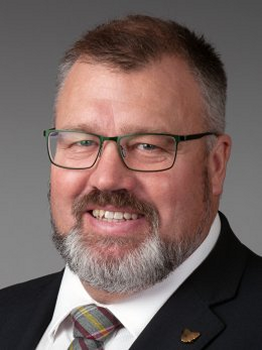
The office of Legislative Council President actually has a longer history than its title, for in the original Legislative Council (1825-55) the post carried the title of Speaker. When Tasmania gained a bicameral Parliament in 1856 this title passed to the lower House, as was the case in Great Britain, and the Legislative Council post became known as the President.
Roles and Duties
These are similar to those of any other Presiding Officer of a Parliament, especially those which follow the English model. Fundamentally, this requires the maintenance of order in the Chamber during parliamentary sittings. The President does not have a vote in Council debate so as to help maintain a degree of neutrality should he or she need to rule if disputes occur. However, the President may take part in the Committee stage of debate on any Bill as it deals with the detail rather than the policy or principle of the legislation. Finally, the President may also be called upon to cast a vote at times when the vote on the Floor of the Council has become deadlocked.
The President's authority in the Chamber during sittings is rarely questioned, except when on occasion a Member may take objection to one of his rulings. It is the President who determines who shall speak, and all Members are supposed to direct their speeches through him or her rather than directly to other Members. If there are queries as to the validity of issues before the Council it is the President, often in consultation with the Clerk of the Council, who settles the issue.
Outside the sittings of the Council, the President exercises the authority of the most senior officer of the Parliament and is acknowledged in standing immediately after the members of the Executive Council (the Governor and the Cabinet). He is the representative of the Council in all matters, including dealings with the Governor and other dignitaries, and is responsible for conveying Bills which have been passed by the Parliament to the Governor for the Royal Assent.
The President is also responsible for the administration and smooth operation of the Legislative Council. He is a member of various committees which affect the running of Parliament and the maintenance of Parliament House and is ultimately responsible for the appointment of staff.
List of Presidents of the Legislative Council
The President's Chair
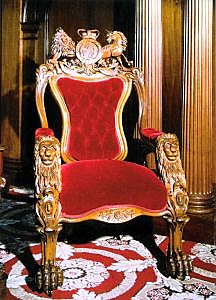
The Chair was built by the cabinet making and upholstery firm of Whitesides and Son of Liverpool Street, Hobart. It is constructed of selected native blackwood and is without doubt the finest and most handsome piece of its kind in Australia.
The design is essentially of large cabriole pattern with the front legs terminating in lions’ paws.
The national emblem of rose, shamrock and thistle form the Coat of Arms of the United Kingdom and Ireland and have been painstakingly carved in the centre of the front rail with the Royal Coat of Arms above it.
Such was the workmanship in this Chair that Whitesides and Son was appointed as cabinetmaker to His Royal Highness the Duke of Edinburgh in 1868 following his visit to Tasmania that year, at which time he opened the sitting of Parliament, having given his address from the Chair.
Members of the Legislative Council
There are 15 Members of the Legislative Council.
Members of the Legislative Council are elected for a fixed six-year term.
List of Members of the Legislative Council
Chair of Committees
The Chair of Committees in the Legislative Council is also elected by fellow Members through the process of a ballot. He or she takes the Chair at the Table of the Council whenever the Council goes into Committee to consider a Bill in detail. In the absence of the Presiding Officer, the Chair of Committees performs the duties and exercises the authority of the President.
The Chair of Committees needs to have a sound knowledge of the rules which govern procedure, particularly during Committee stage consideration of a Bill. The particular rules which are applied to sittings of the Council are known as Standing Orders. Specific Standing Orders are applied during Committee stage consideration of a Bill and it is the responsibility of the Chair of Committees to ensure that the appropriate Standing Orders are adhered to.
During the Committee stage, amendments can be made to a Bill. In some cases several amendments can be proposed to one clause of a Bill and the Chair of Committees at this time must ensure, in the first instance, that the amendments are acceptable to the Chair and, further, that proper procedure is followed to allow the amendments to be debated and voted upon.
The Chair of Committees continues in office until death, resignation, periodical retirement or removal by the vote of an absolute majority of the Council.
Leader of the Government
The Leader of the Government in the Legislative Council is an elected Member who is appointed by the Premier of the day.
The Leader is the Government’s appointed representative in the Legislative Council who is responsible for the passage of Government legislation through the Council. The Leader and his or her Deputy represent all Ministers who sit in the Assembly and their respective portfolios, e.g. Justice, Health, Education and Primary Industries. Officers from these various Departments are usually present in the Chamber during consideration of Legislation applicable to their own Department. Advisers, as they are more commonly known within the Parliament, are present to assist the Leader and Deputy with queries raised by Members during the various stages of consideration of a Bill.
The Leader decides the order in which legislation will be considered and also suggests the sitting schedule of the Council.
The Leader and Deputy have their own office staff consisting of a Senior Private Secretary, Parliamentary Adviser, Electorate Officer and Secretarial Assistant. They are permitted on the floor of the Council during sitting times to assist the Leader with procedural motions and the preparation of information to allow the Leader to adequately and accurately present Government legislation to the Legislative Council for its consideration.
Clerk of the Legislative Council
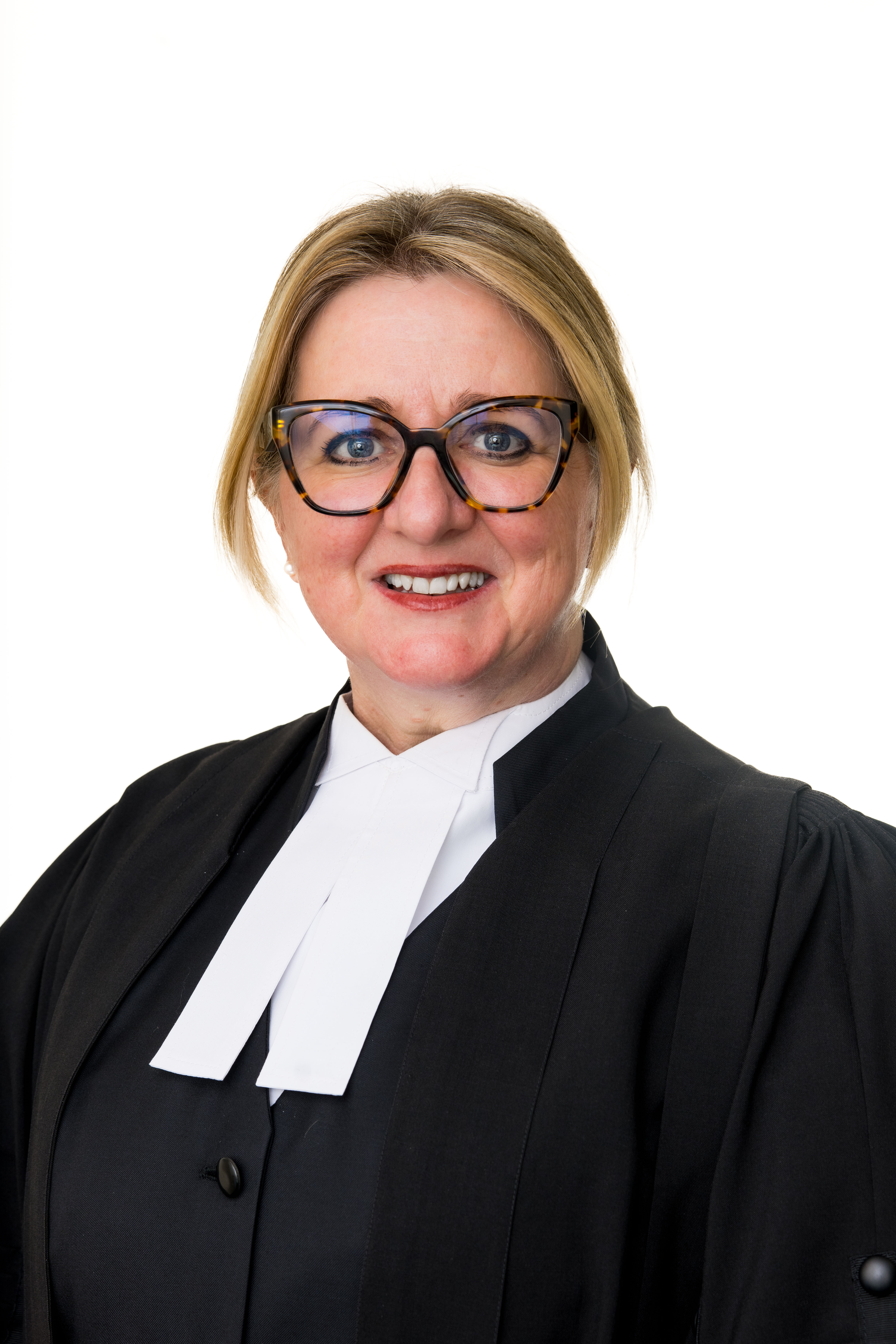
The Clerk of the Council is appointed by Letters Patent issued by His Majesty King Charles III and is the Permanent Head and Chief Executive of the staff of the Legislative Council.
The Clerk is responsible for ensuring that the correct procedure is observed during the passage of legislation and may be called upon to advise the President on the interpretation of Standing Orders and Parliamentary practice. The Clerk is also responsible for the preparation of the Notice Paper and the compilation of the Votes and Proceedings, the official record of proceedings in the Council.
The Clerk Tables Papers in the Council and reads aloud the titles of Bills as each stage is agreed to by the Council.
It is the Clerk who must prepare and certify to the accuracy of Bills agreed to by both Houses, before they are submitted for Royal Assent by the Governor.
The Clerk is assisted in the administration of the House by the Deputy Clerk.
Usher of the Black Rod
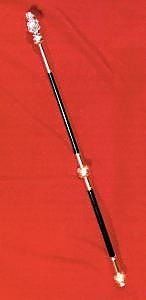
The Black Rod is a symbol of authority of the Legislative Council as a formal arm of the Parliament. It is made of ebony and carved gold with a lion holding the motto of the Order of the Garter – ‘Honi Soit Qui Mal Y Pense’ (meaning ‘evil to him who evil thinks’). Research dates Tasmania’s Black Rod to the early 1870s, making it the second oldest Black Rod still in use in the Commonwealth of Nations.
The Usher of the Black Rod at the Governor’s command, summons the House of Assembly Members to the Legislative Council Chamber to hear the Governor’s speech opening the Parliament following a State election. This position can be traced back through the Westminster Parliament, London, to the year 1348 and the foundation of the Order of the Garter.
During the Middle Ages, the Usher of the Black Rod acted as the King’s ceremonial bodyguard at the Palace of Westminster; King and Parliament working together in the same buildings. When King Henry VIII took over Cardinal Wolsey’s former residence as his new London Palace, the Usher of the Black Rod remained at Westminster and it was from this time that the more modern role of this position was developed.
The Usher of the Black Rod in the House of Lords, London, still takes an active part in ceremonies surrounding the ancient Order of the Garter.
The Tasmanian Black Rod has no similar connection with this order of chivalry. This position, however, is closely related to its London counterpart, in that he or she is the personal attendant upon the Sovereign or her representative at the Opening of Parliament. The Usher of the Black Rod at the direction of the President has responsibility for the maintenance of order and security in the Chamber and the Legislative Council Parliamentary precinct.
At the commencement and termination of each sitting of the Council, the Usher of the Black Rod precedes the President to and from the Chamber.
